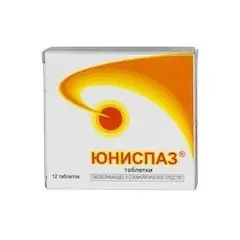- Author Rachel Wainwright [email protected].
- Public 2023-12-15 07:39.
- Last modified 2025-11-02 20:14.
Unispaz
Unispaz: instructions for use and reviews
- 1. Release form and composition
- 2. Pharmacological properties
- 3. Indications for use
- 4. Contraindications
- 5. Method of application and dosage
- 6. Side effects
- 7. Overdose
- 8. Special instructions
- 9. Application during pregnancy and lactation
- 10. Use in childhood
- 11. In case of impaired renal function
- 12. For violations of liver function
- 13. Use in the elderly
- 14. Drug interactions
- 15. Analogs
- 16. Terms and conditions of storage
- 17. Terms of dispensing from pharmacies
- 18. Reviews
- 19. Price in pharmacies
Latin name: Unispaz
ATX code: N02BE51
Active ingredient: drotaverine (drotaverine) + codeine (codeine) + paracetamol (paracetamol)
Manufacturer: Unique Pharmaceutical Laboratories (India)
Description and photo update: 2018-27-07
Prices in pharmacies: from 95 rubles.
Buy

Unispaz is a drug with antipyretic, analgesic, antispasmodic action.
Release form and composition
The dosage form of Unispaz - tablets: brownish-pink with light and dark blotches, oblong, on one side with a risk (in a cardboard box 2 blisters of 6 tablets).
Active ingredients in 1 tablet:
- paracetamol - 500 mg;
- codeine phosphate - 8 mg;
- drotaverine hydrochloride - 40 mg.
Auxiliary components: corn starch, povidone, pregelatinized corn starch, magnesium stearate, purified talc, crospovidone, microcrystalline cellulose, red dye iron oxide.
Pharmacological properties
Pharmacodynamics
The action of Unispaz is due to the properties of its constituent components:
- paracetamol: has an antipyretic and analgesic effect, mainly by inhibiting the synthesis of prostaglandins in the central nervous system and, to a lesser extent, by peripheral effects, blocking prostaglandins and other active substances that stimulate pain receptors;
- codeine: belongs to the number of centrally acting antitussives that also have an analgesic effect, which occurs due to interaction with opioid receptors involved in the transmission of pain impulses in the central nervous system; potentiates the analgesic effect of paracetamol;
- drotaverine: is an isoquinoline derivative, has an antispasmodic effect on smooth muscles (due to inhibition of phosphodiesterase 4 and an increase in cAMP concentration). Drotaverine also has a weak inhibitory effect on calmodulin-dependent calcium channels. It is effective for smooth muscle spasms, regardless of the type of autonomous innervation. Acts on smooth muscles located in the vascular, gastrointestinal, urogenital and biliary systems.
Pharmacokinetics
After oral administration, paracetamol and codeine are rapidly absorbed from the gastrointestinal tract, distributed in most tissues and organs of the body (codeine is mainly in parenchymal organs - spleen, kidneys, liver).
Codeine crosses the blood-brain and placental barriers, is excreted in breast milk.
Paracetamol is metabolized primarily by conjugation.
T 1/2 (half-life): paracetamol - 1.25-3 hours; codeine - approximately 2.9 hours
With urine, about 85% of paracetamol and 90% of codeine are excreted within 24 hours.
Indications for use
According to the instructions, Unispaz is prescribed for pain syndrome of mild and moderate intensity, caused, among other things, by smooth muscle spasms:
- headache;
- toothache;
- joint / muscle pain;
- spastic constipation;
- neuralgia;
- spasms of the bladder and ureter;
- sciatica;
- algodismenorrhea;
- renal, bilious, intestinal colic;
- other spastic conditions of internal organs.
Contraindications
Absolute:
- severe renal / hepatic impairment;
- deficiency of glucose-6-phosphate dehydrogenase;
- severe heart failure;
- AV block II and III degree;
- bronchial asthma;
- intracranial hypertension;
- respiratory failure;
- chronic alcoholism;
- condition after traumatic brain injury;
- drug addiction;
- blood diseases (leukopenia, thrombocytopenia, agranulocytosis);
- combination therapy with monoamine oxidase inhibitors (including a period of 14 days after their cancellation), as well as with drugs containing paracetamol;
- pregnancy and the period of breastfeeding;
- age up to 6 years;
- individual intolerance to the components of the drug.
Relative (Unispaz is prescribed under medical supervision):
- constitutional hyperbilirubinemia (Gilbert's syndrome);
- elderly age.
Instructions for use of Unispaz: method and dosage
Unispaz is taken orally.
A single dose is 1-2 tablets, if necessary, a second dose is possible after 8 hours. In order to achieve a quick effect, Unispaz should not be taken with food.
The maximum daily dose for no longer than three days is 6 tablets. For a longer course, the daily dose is 4 tablets.
A single dose for children 6-12 years old is 0.5-1 tablet. When using the drug 2 times a day, the interval between doses should not be less than 10-12 hours. Maximum 2 tablets per day.
In case of severe impairment of renal / hepatic function, Unispaz should be taken in a reduced dose. In patients with a glomerular filtration rate of up to 10 ml / min, the interval between two doses should be at least 12 hours. Patients belonging to this group can take the drug only sporadically.
Unless otherwise prescribed by a doctor, the course of taking Unispaz should not exceed three days.
Side effects
- central nervous system: dizziness, headache, drowsiness;
- digestive system: constipation, nausea; rarely (in cases of taking high doses) - toxic liver damage;
- cardiovascular system: tachycardia, arterial hypotension, hot flashes;
- allergic reactions: skin rash; very rarely - swelling of the nasal mucosa, bronchospasm;
- hematopoietic system: thrombocytopenia, agranulocytosis.
Overdose
The main symptoms: circulatory disorders, vomiting, nausea, respiratory depression, toxic liver damage (up to necrosis).
Therapy: gastric lavage, saline laxatives. In cases of severe damage to the central nervous system, in order to control the condition, it is possible to administer naloxone, carry out artificial ventilation, and provide oxygen.
special instructions
During the period of therapy with Unispaz, alcohol is prohibited.
In renal / hepatic insufficiency, the dose is set individually.
In cases of a long course or taking high doses, control of the peripheral blood picture and the functional state of the liver (the number of platelets, leukocytes, creatinine levels and the activity of liver enzymes in the blood plasma) is shown. After using Unispaz in high doses, the clinical symptoms of the hepatotoxic effect begin to appear within 48-72 hours.
Influence on the ability to drive vehicles and complex mechanisms
During therapy with Unispaz, the ability to drive vehicles is assessed individually based on the patient's response to the drug.
Application during pregnancy and lactation
Unispaz is not prescribed during pregnancy / lactation.
Pediatric use
- up to 6 years: therapy is contraindicated;
- 6-12 years: Unispaz is used at a reduced dose.
With impaired renal function
- severe renal failure: therapy is contraindicated;
- renal failure: the regimen for receiving Unispaz is set individually.
For violations of liver function
- severe hepatic impairment: therapy is contraindicated;
- hepatic impairment: the regimen for receiving Unispaz is set individually.
Use in the elderly
Unispaz therapy in elderly patients should be carried out under medical supervision.
Drug interactions
Possible interactions:
- levodopa: a decrease in its effectiveness (due to drotaverine), which increases the likelihood of increased rigidity and tremor;
- rifampicin, barbiturates, antiepileptic drugs, tricyclic antidepressants, salicylamide, alcohol (drugs that induce liver enzymes): the concentration of toxic metabolites of paracetamol increases;
- chloramphenicol: its half-life and toxicity increases (due to paracetamol);
- doxorubicin: the risk of developing liver dysfunction increases (due to paracetamol);
- uricosuric drugs: their effectiveness decreases (due to paracetamol);
- metoclopramide, domperidone: absorption of paracetamol is enhanced;
- cholestyramine: absorption of paracetamol decreases, the risk of bleeding increases;
- drugs with hypnotic, analgesic and sedative effects: their effect is enhanced (due to codeine).
Analogs
The analogue of Unispaz is No-shpalgin.
Terms and conditions of storage
Store at temperatures up to 30 ° C. Keep out of the reach of children.
The shelf life is 3 years.
Terms of dispensing from pharmacies
Dispensed by prescription.
Reviews about Unispaz
According to reviews, Unispaz is most effective for headache and toothache, muscle spasms, etc. The development of adverse reactions is not often reported.
Price for Unispaz in pharmacies
The approximate price for Unispaz (12 tablets) is 78 rubles.
Unispaz: prices in online pharmacies
|
Drug name Price Pharmacy |
|
Unispaz N tablets 12 pcs. RUB 95 Buy |

Maria Kulkes Medical journalist About the author
Education: First Moscow State Medical University named after I. M. Sechenov, specialty "General Medicine".
Information about the drug is generalized, provided for informational purposes only and does not replace the official instructions. Self-medication is hazardous to health!






